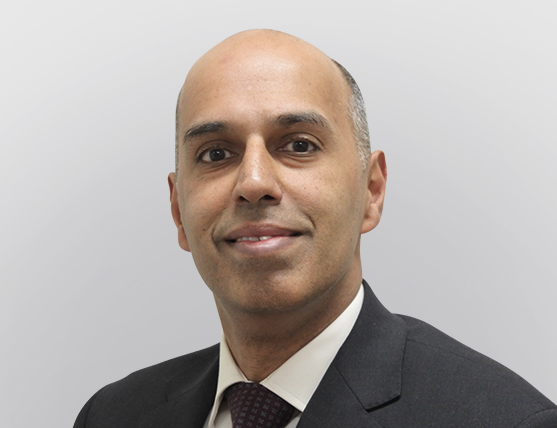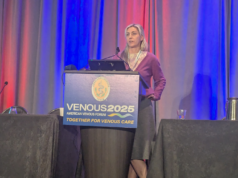
Although the venous stent is still a young technology, it is already offering new and exciting opportunities to patients with deep venous occlusive disease. Venous News spoke to Manjit Gohel (Cambridge, UK) about how his experience in with deep venous stenting, and how he believes the field can continue to build on recent progress and move towards the “holy grail” of venous stent design—high flexibility, high radial force and high crush resistance.
What led to your focus on deep venous disease?
Quite simply, patient need. For many years, the focus has been on treating superficial venous reflux and enormous advances have been made in this area. For many patients, only the superficial veins need treatment, so the new generation of endovenous ablation modalities are very welcome. However, there remains a largely neglected group of patients with venous outflow obstruction who are either undiagnosed, or have been told that there is nothing that can be done. The availability of a range of stents specifically designed for the treatment of deep venous occlusive disease has opened tremendous new opportunities for this patient group.
Which components are required to set up a deep venous practice?
An effective deep venous service is much more than simply being able to offer a stenting procedure. Patients with venous disease are a complex, heterogeneous group. They are often elderly and frail, and have multiple factors contributing to their clinical presentation and promoting venous hypertension. Multidisciplinary care should be the bedrock of any service and all relevant specialties should be involved when setting up care pathways. Vascular surgeons, interventional and diagnostic radiologists, haematologists and specialist nurses may all play an important role. In our practice, there is also a large emphasis on improving links with primary care physicians and community nursing teams. Most patients with advanced venous disease present to, and are managed in primary care settings. Finally, despite the widespread enthusiasm for deep venous interventions, this is a novel and controversial area. Therefore, standardised treatment algorithms and robust audit of outcomes are also imperative.
How do you decide what treatment the patient will receive?
Any treatment pathway should be patient-centred and focus on the severity of symptoms and impact on patient quality of life. All patients undergo detailed clinical assessment and evaluation of disease severity. In patients with significant symptoms or complications of chronic venous hypertension, appropriate investigations are used to identify potentially treat – able venous disease. The mainstay of venous investigation is colour venous duplex ultrasound scanning performed by an experienced team of vascular scientists. Although detailed iliocaval venous assessment is entirely feasible using duplex alone, additional imaging using cross-sectional modalities or venography is often necessary. In our practice, adjuvant proximal deep venous imaging is reserved for patients with strong clinical or duplex suspicion of venous outflow obstruction. Venous claudication or findings such as common femoral vein post-thrombotic change or loss of normal phasicity on duplex are suspicious for proximal occlusive disease. While some clinicians may advocate routine proximal deep venous imaging, we know that incidental non-thrombotic iliac vein (NIVL) lesions are common and not always significant. The management of patients with a combination of venous outflow obstruction, superficial and deep reflux is a real challenge. In general, the proximal deep venous obstruction should be ad – dressed first, followed by superficial reflux. However, these decisions are often complex and should be made on an individual patient basis.
What is the importance of stent flexibility and radial force for deep venous stenting procedures?
There are now a range of available stents, specifically designed and approved for use in the deep venous system. While our understanding is far from complete, the requirements of venous stents are entirely different to stents used in the arterial system. It is interesting that the currently available deep venous stents range from highly rigid, strong closed-cell designs offering high radial force and crush resistance, to much more flexible, open-cell stents, with a range in between. It would seem logical that in the relatively immobile common iliac vein at the May-Thurner point, a stent with high radial force and crush resistance would be favourable. Conversely, in the distal iliac vein and common femoral vein, one could make a case for a more flexible stent as the venous segments are more mobile. However, there is little or no evidence to support these assumptions and further work is urgently needed. Because of the perceived trade-off between stent flexibility and radial force/crush resistance, some believe that a single “perfect” deep venous stent is not possible. However, multiple medical device companies have taken an interest in deep venous stenting, resulting in rapid technology advances in this field. Stents with excellent flexibility and strength attributes are undoubtedly feasible. Whether these mechanical attributes translate to better technical and clinical outcomes in the future remains to be seen.
What are your thoughts on the forces affecting the venous anatomy at the inguinal ligament?
In a fast-moving area, we are all learning new things about the deep venous system. It is widely accepted that the key principles for successful deep venous stenting are to stent from normal vein to normal vein and to ensure that adequate inflow is present. Early concerns about stenting across the inguinal ligament have been largely disproved and stenting into the distal common femoral vein is necessary in many patients. However, the area under the inguinal ligament is of interest, as some stent fractures have been observed in this area. The repeated focal band-like extrinsic compression inflicted by the inguinal ligament may be a factor. In our practice, overlapping of stents in the region of the inguinal ligament is avoided wherever possible.
Which venous stents do you currently use and why?
The treatment of venous outflow obstruction is an expanding field and several different stents are now available. It is important to regularly review the available technology and consider which stents to use, but there are no clinical trials directly comparing different stents or any strong evidence to suggest that one stent is superior to others. Therefore, we have available stents with a range of attributes, including high radial force/ crush resistance stents and much more flexible stents. On an individual case basis, working in a multidisciplinary team, planning decisions can be made about which specific stent should be used in which location. We commonly use a combination of different stents in the same patient. As with many areas of venous disease management, stenting choices are largely dictated by individual clinicians based on local experience and preferences, rather than high-quality evidence. Hopefully, ongoing research will help shed some light over which stent attributes are most important in which locations.
What are your predictions for the field of venous stenting over the next five years?
I expect an ongoing expansion in the uptake of venous stenting procedures around the world. I hope that the provision of stenting procedures is accompanied by efforts to improve patient care pathways and improve links with primary care services to target patients with advanced venous disease and ulceration. As we learn more, newer generation stents will hopefully get closer to the “holy grail” of high flexibility with high radial force/crush resistance. Hopefully, we will see an expansion in published data and greater efforts to combine data across centres. As with any novel intervention, over-diagnosis and over-treatment is a concern. We need to resist the temptation to treat every lesion, but rather work towards evidence-based consensus over which patients benefit most from deep venous interventions.
Manjit Gohel is a consultant vascular and endovascular surgeon at Cambridge University Hospitals, Cambridge, UK









